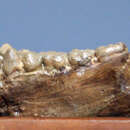zh-TW
在導航的名稱


Els pliopitècids (Pliopithecidae) són la família d'hominoïdeus fòssils més primitiva coneguda. Aparegueren a Àfrica i s'estengueren a Europa abans d'extingir-se fa uns quants milions d'anys. Igual que els gibons d'avui en dia, estaven adaptats per viure a les copes dels arbres de boscos densos. La seva anatomia tenia caràcters primitius, com ara el neurocrani petit, el musell llarg i (en algunes espècies) la presència d'una cua, però també tenia caràcters més avançats, com ara visió estereoscòpica i dents típiques dels hominoïdeus, cosa que els distingia clarament dels micos.[1]
Els pliopitècids (Pliopithecidae) són la família d'hominoïdeus fòssils més primitiva coneguda. Aparegueren a Àfrica i s'estengueren a Europa abans d'extingir-se fa uns quants milions d'anys. Igual que els gibons d'avui en dia, estaven adaptats per viure a les copes dels arbres de boscos densos. La seva anatomia tenia caràcters primitius, com ara el neurocrani petit, el musell llarg i (en algunes espècies) la presència d'una cua, però també tenia caràcters més avançats, com ara visió estereoscòpica i dents típiques dels hominoïdeus, cosa que els distingia clarament dels micos.
The family Pliopithecidae is an extinct family of fossil catarrhines and members of the Pliopithecoidea superfamily.
Their anatomy combined primitive features such as a small braincase, a long snout, and a tail. At the same time, they possessed more advanced features such as stereoscopic vision and ape-like teeth and jaws, clearly distinguishing them from monkeys.[1]
Begun and Harrison divide the Pliopithecidae into subfamilies Pliopithecinae and Crouzeliinae.[2] Dionysopithecinae are sometimes placed here as a subfamily,[3] but Begun & Harrison place them in their own family, the Dionysopithecidae.[2]
The family Pliopithecidae is an extinct family of fossil catarrhines and members of the Pliopithecoidea superfamily.
Their anatomy combined primitive features such as a small braincase, a long snout, and a tail. At the same time, they possessed more advanced features such as stereoscopic vision and ape-like teeth and jaws, clearly distinguishing them from monkeys.
Begun and Harrison divide the Pliopithecidae into subfamilies Pliopithecinae and Crouzeliinae. Dionysopithecinae are sometimes placed here as a subfamily, but Begun & Harrison place them in their own family, the Dionysopithecidae.
Pliopithecidae (pliopitécidos) es una familia extinta de primates catarrinos que se originó a principios del Mioceno.[2] Se originó en África y posteriormente se extendieron hacia Europa, antes de su extinción hace alrededor de 10 millones de años. Al igual que los gibones modernos se habían adaptado a vivir en las copas de los árboles en los bosques densos.
Su anatomía combinaba rasgos primitivos como un cráneo pequeño, un hocico alargado y la cola presente en algunas especies; con otras características más avanzadas como la visión estereoscópica y dientes y mandíbulas como los grandes simios, lo que los distingue claramente de los monos.[3] Se caracterizan por presentar sólo dos premolares, al igual que otros catarrinos, así como una morfología dentaria particular, con unas crestas del esmalte que constituyen el llamado “triángulo pliopitecino” en los molares inferiores.
Pliopithecidae (pliopitécidos) es una familia extinta de primates catarrinos que se originó a principios del Mioceno. Se originó en África y posteriormente se extendieron hacia Europa, antes de su extinción hace alrededor de 10 millones de años. Al igual que los gibones modernos se habían adaptado a vivir en las copas de los árboles en los bosques densos.
Pliopithecidae zijn een familie van uitgestorven zoogdieren die leefden van het Vroeg-Oligoceen tot het Mioceen.
Enkele primitieve kenmerken van deze familie zijn: een lange snuit, kleine hersenholte en (soms) een staart. Ondanks deze kenmerken waren het wel de eerste echte apen. De vorm, gebitskenmerken en stereoscopisch zicht waren de ontwikkelde kenmerken.
Ze waren aangepast aan het leven in de boomtoppen van dichte bossen.
Hun ontwikkeling begon zeer waarschijnlijk in Afrika in het Vroeg-Oligoceen, ongeveer 35 miljoen jaar geleden. Hun uitsterven vond plaats in het Mioceen, 10 miljoen jaar geleden.
Pliopithecidae zijn een familie van uitgestorven zoogdieren die leefden van het Vroeg-Oligoceen tot het Mioceen.
Pliopithecidae là một họ khỉ mũi hẹp hóa thạch. Chúng có nguồn gốc ở châu Phi, và sau đó lan rộng sang châu Âu, trước khi tuyệt chủng vào khoảng thời gian cách đây 10 triệu năm. Giống như các loài vượn hiện đại, chúng đã thích nghi với môi trường sống trên các ngọn cây trong các khu rừng rậm. Đặc điểm giải phẫu học của chúng kết hợp các đặc trưng nguyên thủy như hộp sọ nhỏ, mõm dài, và một số loài có đuôi. Đồng thời, chúng cũng mang những đặc trưng tân tiến hơn như thị giác lập thể và răng cùng các quai hàm giống như vượn, là đặc điểm phân biệt rõ ràng chúng với khỉ.[1]
Pliopithecidae là một họ khỉ mũi hẹp hóa thạch. Chúng có nguồn gốc ở châu Phi, và sau đó lan rộng sang châu Âu, trước khi tuyệt chủng vào khoảng thời gian cách đây 10 triệu năm. Giống như các loài vượn hiện đại, chúng đã thích nghi với môi trường sống trên các ngọn cây trong các khu rừng rậm. Đặc điểm giải phẫu học của chúng kết hợp các đặc trưng nguyên thủy như hộp sọ nhỏ, mõm dài, và một số loài có đuôi. Đồng thời, chúng cũng mang những đặc trưng tân tiến hơn như thị giác lập thể và răng cùng các quai hàm giống như vượn, là đặc điểm phân biệt rõ ràng chúng với khỉ.